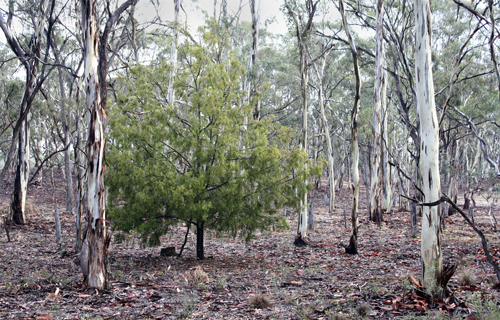On April 6 the Victorian Environment Assessment Council released its final report on its ‘Remnant Native Vegetation Investigation.’ As with all VEAC reports, the document is full of useful information and provocative ideas. In spite of its calm and measured tone, it contains at least one implied criticism of land managers.
The focus of the report was on parcels of native vegetation around the state: small reserves, unused road reservations, and patches on private land.
There are tens of thousands of such parcels throughout the state, half of them on private land ‘in patches closely embedded with and abutting those on public land’. It is surprising to read in the report of their importance to biodiversity:
‘Fragmented landscapes still support the majority of Victoria’s biodiversity. Around 40 percent of Victoria’s native land vertebrate species (mammals, bird, amphibians, reptiles and fish not confined to marine or coastal waters) are virtually restricted to fragmented landscapes in Victoria, and a further 45 percent rely on fragmented landscapes across a major part of their distribution in Victoria. That is, only about 15 percent of our land vertebrates are mostly restricted to largely-intact landscapes. Fragmented landscapes are likely to be similarly important for other species: land invertebrates, fungi and plants…’
Not only that, but such patches are important for agriculture:
‘Agriculture, the vast majority of which occurs in fragmented landscapes, contributes $10.2 billion annually to the Victorian economy. Native vegetation contributes to the overall productivity of landscapes in a myriad of ways. It is crucial to water production and management, maintaining water quality, flood mitigation, salinity control and catchment management. Native vegetation mediates the exchange of nutrients, improves soil quality, helps prevent soil erosion and provides shelter for stock. Loss of native vegetation contributes to the degradation of these ecosystem processes.’
For various reasons management of these parcels of land is under resourced, and VEAC makes a number of recommendations to remedy this. One of them should strike a chord with anyone dealing with DSE and Parks in their management of the box ironbark country. VEAC comments on the ‘vast information base on native vegetation that has been compiled principally by the Department of Sustainability and Environment in recent years.’ Yet one of its most interesting recommendations is that:
‘Managers, contractors and on-ground workers be made aware of their responsibilities and appropriate work protocols whilst working around native vegetation, and that mandatory formal education and training be incorporated into all accredited training courses.’
In other words, the Council is saying what everyone knows: that DSE and Parks operatives too often conduct work in the bush apparently without any consideration of the ecological values of the land they are dealing with. This is particularly true of fire management and track maintenance. The ‘vast’ knowledge is safe in a DSE filing system, and doesn’t affect practices on the ground.
Threats and remedies
These environments are under threat, and the Council makes it clear that prevention of loss is better than planting trees when it comes to native vegetation: ‘The substantial majority of Victoria’s biodiversity that occurs in fragmented landscapes continues to decline, even though there has been significant abatement of some of the major threatening processes, such as broad-scale land clearing, in recent decades…Preventing habitat loss and improving the condition of native vegetation is, by many orders of magnitude, more cost-effective than revegetation and has significantly better conservation outcomes.’
Among other things, the Council recommends greater involvement by the community in management of remnant vegetation:
‘Within five years, a program be completed to identify and reduce impediments to local-scale cooperative actions between public land managers and willing community members, and to establish a simple system to facilitate the uptake by organisations and individuals of stewardship agreements over small public land reserves.’
It will be interesting to look back in five years’ time, to see what has been done.
The full report can be read at
http://www.veac.vic.gov.au/investigation/remnant-native-vegetation-investigation





 Click on image for info/order page
Click on image for info/order page Click on image for info/order page
Click on image for info/order page Click on image for info/order page
Click on image for info/order page




















